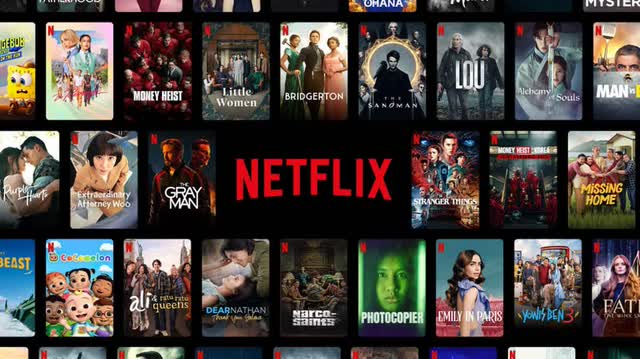Summary:
- Netflix’s Q1’24 earnings release will be determined by subscriber growth, strong margins, and average revenue per user.
- The company’s organic growth and potential beat in revenue could be the earnings story.
- Netflix’s dominant position in the streaming sector is due to the missteps of its competitors, giving it clear sailing ahead.
Dean Mitchell
Above: Something for everyone works – proof of a business model
As Netflix, Inc. (NASDAQ:NFLX) approaches its Q1’24 earnings release this week, the market sentiment whether it reports a meet, beat, or miss comes down to this:
If subscriber growth is up, margins are strong, and average revenue per user ticks up, it’s clearly a win. So the idea that the stock has gotten top-heavy bears no consequence, even if there is a profit-taking sell-off.
Above: One size fits all works as a key strategy.
Consensus Q1’24E revenue is $9.28b. Our calculation sees a possible beat based on new sub momentum not as dependent on password sharing end or ad support policy which last year was the dominant rationale for upside growth.
We are looking for revenue to beat consensus at $9.7b.
Consensus is looking for $4.50ish EPS up a huge 55.9% y/y gain. We believe organic growth will be the earnings story.
But average revenue per user has flattened for the last three years as they may not support my organic growth thesis. At the same time, company margins could have improved. Also, the last year full year $1b decline in FCF will be reversed:
Average revenue per user:
2021: $11.67.
2022: $11.76.
2023: $11.87.
Given the 234m subs base, that’s lots of shiny new pennies.
The two key moves have been the end of password sharing and adding ad-supported pricing. If these have been the core of total subscriber growth it proves beyond question that the business is built on moving wallpaper, not creative genius.
In other words, NFLX has realized that the plethora of content available on all services has jaded viewers who are more than happy with just something pleasant to pass the time. Hits do count, but not as much as a role in where sub dollars go.
If Q1’24 appears to continue pacing a well-defined path this year, we can see a few challenges to the premise that the stock is overvalued that would resonate with Mr. Market. The price of $628 at writing Mr. Market has awarded the stock echoes the trading trend on Nov. 2021. That’s when the stock sold at $682 just before the big swoon on May of 21 when it traded at $171. This could be a warning signal to happy holders of the old boxing saw:
The bigger they are, the harder they fall. In our view, while recognizing that old adage, we are more inclined to believe that the upside will not only hold, but accelerate.
Our reasoning comes not so much from specific marketing or operational efficiencies in a still growing market but from our assessment of the competitive field.
Consider the solutions apparently pursued by peers that could result in market share gains poached from NFLX:
The Walt Disney Company (DIS): The proxy fight victory may give CEO Iger breathing room for initiatives DIS has already taken, but none promise to raise the sub-profile of the leader. In fact, DIS faces bigger challenges ahead in its Parks division as Comcast’s hard-charging expansion thrust in its Universal Parks sector for its IP. It could well poach a share of total attendance from DIS. Neither is there much of DIS IP in its streaming service, which is rapidly aging out – not the case with Universal. And the 600lb gorilla of a debut, while nicely reduced, lingers on.
Paramount Global (PARA): At writing, two things are clear. Shari’s apparent decision to keep on the Skydance deal trail at least until she moves closer to a close. But Paramount, albeit with improved numbers ahead, has no defining answer we can see to the great streaming dilemma. PARA holders will have the final say if and when a Skydance deal is inked, and they hit the courts immediately to challenge its fairness.
Warner Bros. Discovery, Inc. (WBD): The company has produced a few nice survival tricks, like tax sleight of hand and cancellation of film and TV production. Its forward solutions to its own streaming dilemmas pave no innovative marketing moves that amount to a serious share challenge to NFLX.
WBD remains heavily dependent on cable cash flow against the cord-cutting bleed. Their answer remains in sell-offs, spin-offs, or acquisitions. They appear not as yet ready to move on. Thus far, they have not apparently found the yellow brick road to go head-to-head with the pure play of NFLX on the streaming vertical. Zaslav and Malone have yet to find the path.
The second-tier streamers are apparently happy with their niche positions, awaiting possible offers from the biggies.
It seems clear to us that NFLX’s dominance in the steaming sector has grown in great measure since 2022 due to the false steps taken by its competitors. And that will remain at least until one of the peers finds the holy grail they have as yet discovered. So what is the message to Mr. Market? Clear sailing ahead with no competitive headwinds from competitors. There are 500m households globally, with plenty of organic ramps ahead for NFLX at 234m today.
Conclusion
NFLX has proven it wrong that the long-term conventional wisdom of the media/entertainment space that creating IP and spreading it over countless platforms: theaters, TV, streaming, live entertainment, merchandising, and parks is the road to riches. Instead, what its solid business model proves is that mass content’s genius is that, at a single vertical, you will have something to offer everyone at any time at a price comfortable enough to hold loyalty over time.
At the same time, it should be an object lesson to NFLX not to toe-dip in any related vertical among those listed by peers. Smarter still is sticking to is strengths, and dance with them that brought you. As first mover in the field, the company built a customer base that’s difficult to dislodge. It took the headwinds of the early 2000s with a better plan to withstand the pressures than peers. Netflix offering a one-size-fits-all proposition to the market wins the day and will continue to do so.
If it stays the course with a steady rise in subs, and keeps its content costs around $17b, it faces a clear path to even bigger returns to shareholders, even against the current strong positioning.
We see a steady upside building this year against peers who still do not appear to have a solid challenge strategy.
Analyst’s Disclosure: I/we have no stock, option or similar derivative position in any of the companies mentioned, and no plans to initiate any such positions within the next 72 hours. I wrote this article myself, and it expresses my own opinions. I am not receiving compensation for it (other than from Seeking Alpha). I have no business relationship with any company whose stock is mentioned in this article.
Seeking Alpha’s Disclosure: Past performance is no guarantee of future results. No recommendation or advice is being given as to whether any investment is suitable for a particular investor. Any views or opinions expressed above may not reflect those of Seeking Alpha as a whole. Seeking Alpha is not a licensed securities dealer, broker or US investment adviser or investment bank. Our analysts are third party authors that include both professional investors and individual investors who may not be licensed or certified by any institute or regulatory body.
The House Edge is widely recognized as the only marketplace service on the casino/gaming/online sports betting sectors, researched, written and available to SA readers by Howard Jay Klein, a 30 year c-suite veteran of the gaming industry. His inside out information and on the ground know how benefits from this unique perspective and his network of friends, former associates and colleagues in the industry contribute to a viewpoint has consistently produced superior returns. The House Edge consistently outperforms many standard analyst guidance with top returns.
According to TipRanks, Klein rates among the top 100 gaming analysts out of a global total of 10,000.

